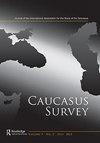马塔斯明达万神殿:一个记忆场所和身份的象征
IF 0.5
Q3 AREA STUDIES
引用次数: 1
摘要
摘要本文探讨了第比利斯马塔斯敏达起义中的作家和公众人物万神殿。后者代表了一个长期以来被广泛认为具有象征意义的记忆场所。万神殿始建于19世纪末,于20世纪20年代开放,被认为是格鲁吉亚集体身份的象征。在接下来的几十年里,作家和公众人物万神殿的地位在很大程度上决定了它的历史,无论是在苏联时期还是之后。本文旨在追溯一个多世纪以来,mattsminda万神殿作为格鲁吉亚身份象征的观念的转变,解释赋予万神殿的意义是如何以及为什么随着时间的推移而演变的,从而有助于形成集体记忆——国家身份的基本要素之一。这项工作借鉴了各种研究中的事实证据和理论判断,以及对反映不同主题特定讨论的论文的分析,以及媒体传播的信息,包括流行的报纸、杂志和官方文件。本文章由计算机程序翻译,如有差异,请以英文原文为准。
The Mtatsminda Pantheon: a memory site and symbol of identity
ABSTRACT The paper deals with the Pantheon of Writers and Public Figures at the Mtatsminda rise in Tbilisi. The latter represents a memory site of widely recognized symbolic importance for a long time. Initiated at the end of the nineteenth century and opened in the 1920s, the Pantheon was conceived of as a symbol of collective identity of Georgia. The status of the Pantheon of Writers and Public Figures has largely defined its history in the following decades, both in the Soviet period and afterwards. The paper aims to trace the transformation of the idea of the Mtatsminda Pantheon as a symbol of Georgian identity over a century, to explain how and why the meanings assigned to the Pantheon evolved over time, thus contributing towards the formation of a collective memory – one of the essential elements of national identity. The work draws upon factual evidence and theoretical judgements presented in various pieces of research, as well as the analysis of papers reflecting different subject-specific discussions, information spread by media outlets, including popular newspapers, magazines, and official documents.
求助全文
通过发布文献求助,成功后即可免费获取论文全文。
去求助
来源期刊

Caucasus Survey
Arts and Humanities-History
CiteScore
1.30
自引率
9.10%
发文量
4
期刊介绍:
Caucasus Survey is a new peer-reviewed, multidisciplinary and independent journal, concerned with the study of the Caucasus – the independent republics of Armenia, Azerbaijan and Georgia, de facto entities in the area and the North Caucasian republics and regions of the Russian Federation. Also covered are issues relating to the Republic of Kalmykia, Crimea, the Cossacks, Nogays, and Caucasian diasporas. Caucasus Survey aims to advance an area studies tradition in the humanities and social sciences about and from the Caucasus, connecting this tradition with core disciplinary concerns in the fields of history, political science, sociology, anthropology, cultural and religious studies, economics, political geography and demography, security, war and peace studies, and social psychology. Research enhancing understanding of the region’s conflicts and relations between the Russian Federation and the Caucasus, internationally and domestically with regard to the North Caucasus, features high in our concerns.
 求助内容:
求助内容: 应助结果提醒方式:
应助结果提醒方式:


